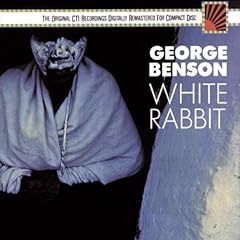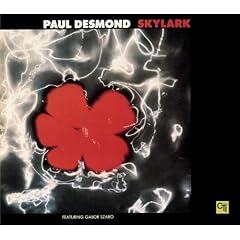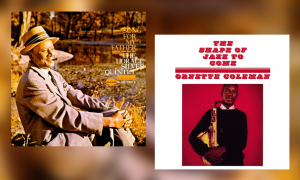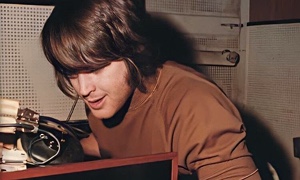Home » Jazz Articles » Building a Jazz Library » Creed Taylor Productions, Part 1
Creed Taylor Productions, Part 1
The place in jazz history held by Creed Taylor is impeccable, stylish, and essential. He produced some of the best music for some of the best labels dedicated to jazz, then formed his own label and with meticulous preparation and his musician's ear kept on making great jazz records.
Taylor began as a producer for Bethlehem Records, where his work with Charles Mingus stands among the label's best. In 1960, he founded Impulse! which released under his leadership such classic Taylor productions as Coltrane's Africa/Brass and Blues and the Abstract Truth with Oliver Nelson.
Taylor moved on to serve as General Manager and Producer for Verve Records, where his work with Antonio Carlos Jobim, Stan Getz, João Gilberto, Charlie Byrd and others fueled the international musical wave of "bossa nova. "The Girl From Ipanema won the 1964 Record of the Year Grammy Award and the album from which it came, Getz/Gilberto, won four more Grammy Awards, including Best Jazz Album and Album of the Year.
After Verve, Taylor teamed with Herb Albert and Jerry Moss to produce Grammy Award-winning sets with Wes Montgomery for A&M/CTI.
Taylor became his own boss in 1968, forming CTI Records—Creed Taylor, Inc. Producer/arranger Don Sebesky, a stalwart from Taylor's Verve and A&M days, was among his first recruits. They shared a resolute gift for creating lush, soft arrangements that simply sound more beautiful than most other jazz records. Their orchestrations of originals, jazz and pop standards, and pop and rock hits, helped define the 1970s fusion genre.
Taylor's CTI roster includes some of the greatest jazz musicians of the time, including Chet Baker, Paul Desmond, Herbie Hancock, Freddie Hubbard, Milt Jackson and bassist Ron Carter, whose refined sense of rhythm and melody has graced a significant portion of CTI's output.
CTI Records also provided artists the opportunity to explore music with a freedom that larger, industrial-sized labels might not have granted, such as The Rite of Spring, Hubert Laws' treatment of work by Stravinsky, Debussy, Bach and Fauré. CTI sets by Hubbard (Red Clay) and Jackson (Sunflower and Goodbye, with Laws) in particular stand among the best work of their considerable careers.
 Chet Baker: She Was Too Good To Me (1974)
Chet Baker: She Was Too Good To Me (1974) Sebesky proves the perfect arranger/conductor for this Baker comeback, with material to match: "Autumn Leaves suits Baker's trumpet (his opening salvo is very like Miles, supple and gentle yet taut and strong), as does the title track, where he sings like he plays, with brittle melancholy, as the strings dance with the spectre of his vocals. Baker coolly swings Hank Mobley's bop "Funk in Deep Freeze. On two tracks, Paul Desmond's astringent alto counterpoints Baker's style and sound.
 Chet Baker/Gerry Mulligan: Carnegie Hall Concert (1974)
Chet Baker/Gerry Mulligan: Carnegie Hall Concert (1974) This final reunion performance by two West Coast giants presents the debut of Mulligan's "A Song for Strayhorn and one of the first recordings of young guitarist John Scofield. Baker's trademark kid-leather glove treatment of "My Funny Valentine (as the notes correctly observe, "a piece Chet owns in all but copyright ) remains the highlight of their joint repertoire; other highspots include the jam scrambles "It's Sandy at the Beach and "Bernie's Tune.
 George Benson: White Rabbit (1971)
George Benson: White Rabbit (1971) Benson's second CTI set comes from Wes Montgomery's linage even as the band (Hancock, Cobham, Laws and Carter) and arrangements of "California Dreamin,' the "Theme from 'Summer of '42' (Michel Legrand), and "Little Train (Villa-Lobos), plus the psychedelic title track, spotlight his sparkling guitar in Spanish-tinged orchestral lushness. Ends with Benson's original "El Mar, featuring 17-year-old Earl Klugh.
 Ray Charles: Genius + Soul = Jazz (1960)
Ray Charles: Genius + Soul = Jazz (1960) The second album released on Impulse! features the label's first single, a cool "One Mint Julep with Charles grooving on electric organ. NOT a pop collection but bursting with seriously swingin' rhythm and blues, mostly arranged by Quincy Jones and Ralph Burns and played by Thad Jones, Clark Terry, Freddie Green and others from the Basie band. The popular reissue combines Charles' Genius with his 1972 release My Kind of Jazz, which kicks out foot-stompin' versions of Lee Morgan's "The Sidewinder and Horace Silver's "Señor Blues.
 Deodato: Prelude (1972)
Deodato: Prelude (1972) Deodato's rejuvenation of Strauss, "Also Sprach Zarathustra, a genius stroke of classical, Brazilian, fusion and funk, was a Grammy-winning top ten hit. The principal on electric keyboards plus bassists Carter and Stanley Clarke, Cobham, and percussionists Airto and Ray Barretto, also deliver the "Spirit of Summer as soft as spring rain; creepin' synthesizer funk ("September 13 ); and updates of Debussy's "Prelude to the Afternoon of a Faun and "Baubles, Bangles & Beads (favored by Sinatra in his sessions with Jobim).
 Paul Desmond: Skylark (1973)
Paul Desmond: Skylark (1973) With his instantly recognizable alto sound—chilled and dry as an ice-frosted martini—Desmond's CTI date bursts with Sebesky-arranged classical (Purcell's "Music For A While ), standard ("Indian Summer ) and pop (Paul Simon's "Was a Sunny Day ) pieces. Guitarist Gabor Szabo and low-groaning cello add a gypsy touch, and the leader soars through "Take Ten, Desmond's derivative of his own classic "Take Five."
 Bill Evans: Conversations with Myself (1963)
Bill Evans: Conversations with Myself (1963) Brilliantly titled and executed, claiming the first of Evans' seven Grammy Awards: Master pianist Evans overdubbed to perform a compelling program with...master pianist Evans. An abundance of Thelonious Monk ("'Round Midnight, "Blue Monk, "Bemsha Swing ) spotlights the lighthearted side that sometimes romped behind Evans' austere visage. The rest—most notably "Stella by Starlight —is sheer, uncompromised genius.
 Gil Evans Orchestra: Out of the Cool (1960)
Gil Evans Orchestra: Out of the Cool (1960) The pianist, composer, arranger and conductor maps out Lydian chromatics as a comfy, large-ensemble twelve-bar blues ("Stratusphunk ) and floats ascending and descending horns like a spaceship ("Bilboa Song ). Arrangements coax amazing voices from his instrumentation yet leave soloists such as Jimmy Knepper, whose trombone digs up jazz' New Orleans roots ("La Nevada, "Where Flamingos Fly ), plenty of room to blow. Evans' finest hour outside of his series with Miles Davis.
 Joe Farrell: Moon Germs (1972)
Joe Farrell: Moon Germs (1972) An electric quartet date where Hancock, Stanley Clarke and Jack DeJohnette construct multi-hued, shifting rhythmic hotplates upon which Farrell cooks with flute and soprano sax. The opening "Great Gorge is one of Farrell's most memorable melodies, his saxophone shadowing Clarke's bass down into the groove, and his flute swings and stings in response to the rhythmic challenges of Clarke's "Bass Folk Song.
 Jürgen Friedrich/Kenny Wheeler: Summerflood (2003)
Jürgen Friedrich/Kenny Wheeler: Summerflood (2003) Composed, arranged and produced by pianist Friedrich, who leads his own quartet plus guest soloist Wheeler. While the composer exercises his own piano chops in "Baghira, Wheeler gorgeously soars above the accompaniment in "Opal, and saxophonist Claudius Valk proves Wheeler's equal in the opening "my shy i (quartet sans Wheeler) and title track. Modern acoustic jazz that embraces Wheeler's warm, personable tone within the sound of European classicism.
 Stan Getz/Charlie Byrd: Jazz Samba (1962)
Stan Getz/Charlie Byrd: Jazz Samba (1962) Warm and cool like a tropical breeze in the sun, quietly unleashing two soft supple minutes that changed music forever: The saxophone and guitar dance through "Desifinado laid the foundation for the international bossa nova movement to follow. Getz commands the forefront in a mere whisper, especially in "Bahia and "Samba Triste, as Byrd and the rhythm section samba and sway through pure rhythmic magic. Indescribably delicious.
Tags
PREVIOUS / NEXT
Support All About Jazz
 All About Jazz has been a pillar of jazz since 1995, championing it as an art form and, more importantly, supporting the musicians who make it. Our enduring commitment has made "AAJ" one of the most culturally important websites of its kind, read by hundreds of thousands of fans, musicians and industry figures every month.
All About Jazz has been a pillar of jazz since 1995, championing it as an art form and, more importantly, supporting the musicians who make it. Our enduring commitment has made "AAJ" one of the most culturally important websites of its kind, read by hundreds of thousands of fans, musicians and industry figures every month.























